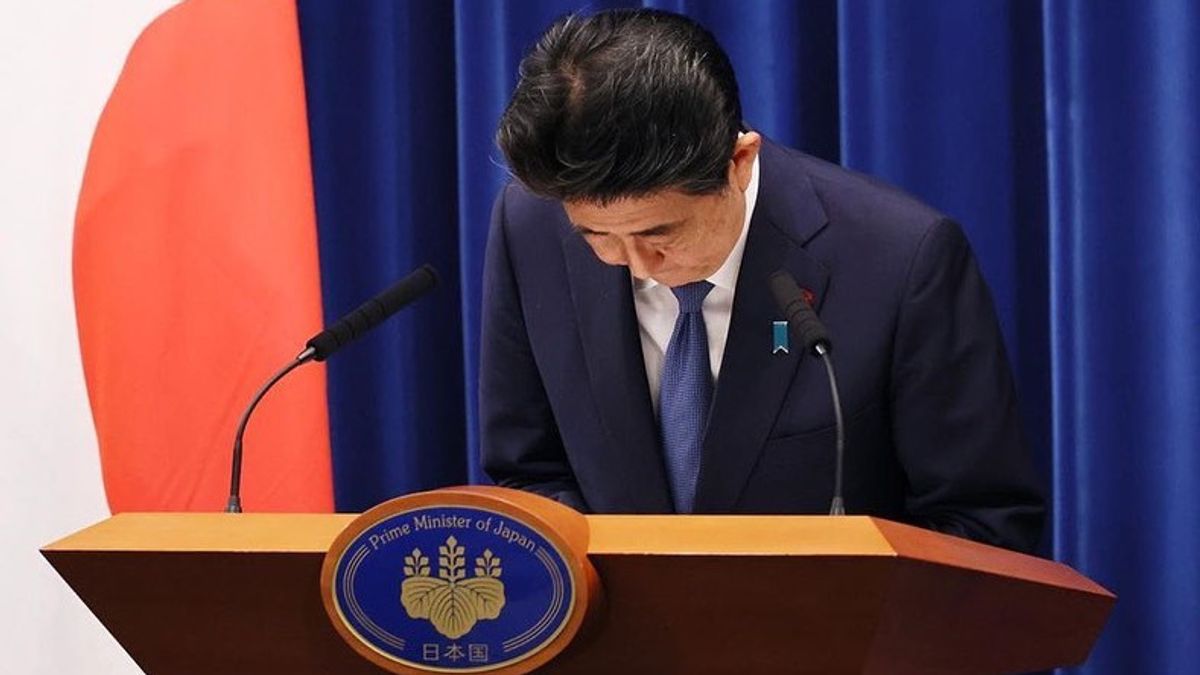JAKARTA - Today, Shinzo Abe turns 66 years old. He just resigned from the position of Prime Minister (PM) of Japan, last August 28. This is quite shocking news, although it is not surprising. His health deteriorated. Abe resigned amidst the war against the pandemic.
In announcing his resignation, Abe said he wanted to make way for a new leader who could focus fully on dealing with the pandemic and other challenges Japan had to face. Abe said the resignation was made in a timely manner because Japan had now entered the second wave of COVID-19.
“For almost eight years I have controlled my chronic disease. But in June this year I did a routine check-up and there were signs of the disease, ”said Abe. "I made the decision that I should not continue my work as prime minister. I need to fight a disease and need to be treated."
According to The New York Times, Abe announced the decision to step down, four days after he set the record for the longest uninterrupted Japanese prime ministerial term. Abe's leadership as PM began in 2006, before he stepped down in 2007 and was re-elected in 2012.
Abe leads Japan in a period of recovery from earthquakes, tsunamis and long-impact nuclear disasters. Under Abe, Japan managed to recover from an impoverished economy. Despite his long reign, Abe failed to achieve his main goal of revising the constitution adopted by the United States (US) after World War II.
Abe also failed to secure the islands contested with Russia. He was unable to get the two countries to sign a peace treaty that would officially end the war.
And in an emotional press conference, Abe expressed his greatest regret, namely the failure to fulfill his ambition of securing Japanese citizens who were kidnapped by North Korea (North Korea). The kidnapping is known to have occurred several decades ago.
Back and forth Abe
Japan has a parliamentary system, in which usually the party leader with the most seats in the lower house of the Diet will become PM. Abe's party, the Liberal Democratic Party (LDP), has held power for several years since its founding in 1955. In September 2006 Abe became PM of Japan.
Abe is the country's youngest PM since World War II. He is also the first PM born after the war. Abe has been a member of the legislature since 1993, although he only joined the cabinet in 2005. As explained above, this resignation is actually not the first. In September 2007, Abe also resigned citing poor health.
In September 2012, Abe returned to leadership of the LDP, after the party won the ballot box. Abe began his second term as PM of Japan on December 26, 2012. In 2014 and 2017, Abe called for snap elections; victory strengthens his control and shows support for his economic reform program.
In 2017, the LDP changed the rules allowing its leaders to serve three terms of office. This has implications for Abe's political destiny. Under the rule Abe can run for a third term as LDP leader again in September 2018. If he holds that leadership role, Abe will remain at the head of government until 2021, making him Japan's longest serving prime minister.
Abe's legacyHowever, scandals and approval downgrades could pose a challenge to Abe's leadership, or even to resign for some reason. True. Abe resigns before 2021 because of his health.
Abe's leadership is not without gaps. Several scandals and controversies occurred. In late 2013 Abe visited Yasukuni Shrine, a Japanese war death memorial that locates World War II criminals.
The visit outraged neighboring countries, such as China and South Korea. On September 19, a few weeks after he stepped down as Japanese prime minister, Abe returned to visit the shrine.
本 日 、 靖国神社 を 参 拝 し 、 今 月 16 日 に 内閣 総 理 大臣 を 退 任 し た こ と を ご 英 霊 に ご 報告 い た し ま し た。 pic.twitter.com/ZpyrtLrpRE
- 安 倍 晋 三 (@AbeShinzo) September 19, 2020
In a 2015 statement marking the 70th anniversary of World War II, Abe repeated past expressions of regret for the war. But he also said he did not want Japan to continue to apologize indefinitely for its acts of war.
His relationship with the United States was considered surprising. Nine days after Trump was inaugurated as US President, Abe became the first foreign leader to visit the US president-elect.

Abe and Donald Trump met at the White House in February 2017, where they shared a 19-second handshake under awkward circumstances. During the visit, Abe also visited Mar-a-Lago, Trump's club in Florida, where the two played golf and received news of a North Korean missile launch.
When Trump traveled to Japan in November 2017, Abe presented him with a hat featuring the slogan: Donald & Shinzo Make Alliance Even Greater. But the relationship was not as productive as Abe had hoped. Trump leaves the Trans-Pacific Partnership.
Trump also surprised Abe when he agreed to a June 2018 summit with North Korean Supreme Leader Kim Jong-un. Yet until then the relationship between North Korea and Japan had never been good.
Even so, Abe's greatest legacy for Japan is stabilization, both in the economy and in diplomatic relations with neighboring countries, especially China. Prior to the COVID-19 pandemic and China's increasingly authoritarian movement in Hong Kong and around the South China Sea, Abe had forged warmer relations with China and President Xi Jinping, reversing years of frozen ties.
"I think Abe's greatest legacy for his successor is that he has managed to stay in power in Japan longer than any other prime minister," said Kristi Govella, assistant professor of Asian studies at the University of Hawaii in Manoa.
"He managed to raise Japan's profile on the international stage and made substantial changes in policy in a number of problem areas and in Japan that is something we rarely see," he added.
The English, Chinese, Japanese, Arabic, and French versions are automatically generated by the AI. So there may still be inaccuracies in translating, please always see Indonesian as our main language. (system supported by DigitalSiber.id)











